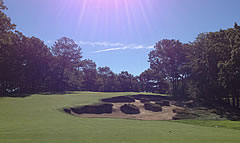
- amateurgolf.com photo
Prior to playing East Hampton Golf Club,
there were two things I heard repeatedly from
people who had played there. The first was
that it’s amazing what Ben Crenshaw and Bill
Coore were able to accomplish with 115 acres.
The second was that the course consists of
two different nines with the implication that
the one “across the street” and among
woodlands was the lesser of the two.
The latter statement couldn’t be further
from the truth, at least in my humble opinion.
On a September morning the day after the
USA won the Walker Cup at National Golf Links
of America, I found myself on the first tee with
a caddie by my side. Once I drove the fairway
of the stout dogleg-right par 4, the flat front
nine, on the site of a former potato farm, was
right out there in front of me. Fescue lines the
well-manicured fairways, with ample driving
areas and fairly obvious clues as to when to
leave the driver in the bag. (For example on
the short second hole if I played the course
often I’m sure I would reach for driver and try
to get there, but it was too early in the day to
mess about in the fescue so I played a safe 3-
wood down the middle.)
The bunkering is rough hewn in the style I
have seen from the Coore/Crenshaw team the
many times I have played the wonderful
Bandon Trails in Oregon. (Check out the Two Man Links
Championship May 4-7, 2014 if you’re
interested in playing there.) The fairways and
green surfaces are fescue grass, which gives
the course a firm, links-style feel, although I
wouldn’t call it a links course in the vein of
National Golf Links by any stretch of the
imagination.
After whipping around the front nine in a
little over an hour, ending with the more tree-
lined par-5 eighth and dogleg right par-4 ninth,
we crossed the street to play the wooded
back nine. Here the terrain becomes more hilly,
and while I didn’t find the driving areas overly
tight, I found the par-3’s and approach shots
to the 4s and 5s much more challenging. There
are some places, notably the 13th, where a
missed approach shot can put you in a world
of hurt. My previously unscathed card found a
double bogey there, and a couple of three
putts on two-tier greens like the par-3 14th.
Trying to bring the round home safely, I
stepped to the tee of the par-3 17th and
looked down at the fairly small target. I’m not
sure why I knew this, but something told me
the hole had a local nickname.
“The shortest par-5 in golf,” my caddie
Dan told me.
After hitting that green and three putting,
I wanted to reach for the driver on the 281
closing hole, but thought better of it when I
saw the look on Dan’s face. I thought about
the long flight home to California and wanted a
positive thought, so hit a 5-iron to the small
fairway, leaving me a sand wedge in to the
small green. A tree overhanging the fairway
would have made hitting driver a low
percentage shot with my ball flight, but it
would have been fun to try. My five-foot birdie
putt fell in the side door, and the 2:20 it took
to play left me plenty of time to enjoy an
awesome lobster roll in the top-drawer
clubhouse (not surprising given the club is
owned by a local builder).
East Hampton, like many of the golf clubs
on Eastern Long Island, is very private. But if
you get the chance to play there, by all means
do so and see what can be done on 115 acres
and 6400 yards on the scorecard. There are a
lot of ways to make golf challenging and fun.